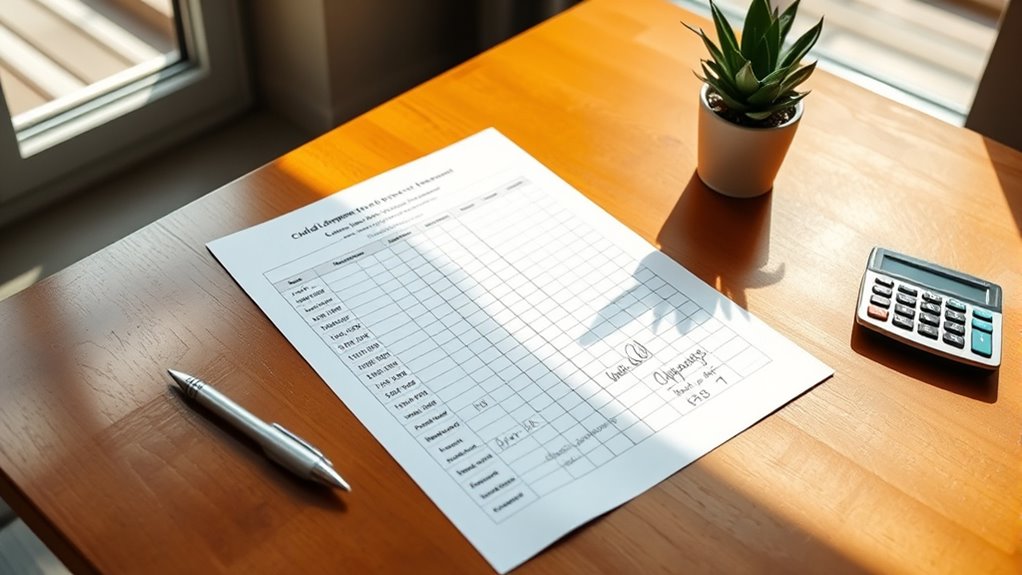A child expense tracking worksheet helps you and your co-parent stay organized and transparent about shared costs. It makes managing expenses like medical bills, school supplies, and activities simple while reducing misunderstandings. Using this tool guarantees both of you are on the same page, promotes fair sharing, and provides records for legal or tax purposes. If you want to learn more about creating an effective worksheet, keep exploring ways to make budgeting easier for everyone involved.
Key Takeaways
- Provides a structured format for co-parents to record and share child-related expenses accurately.
- Promotes transparency and open communication about financial responsibilities.
- Helps identify spending patterns and plan for future costs effectively.
- Serves as a documented record useful for tax deductions or legal purposes.
- Facilitates fair cost sharing and reduces conflicts between co-parents.

Managing your child’s expenses can feel overwhelming, but a child expense tracking worksheet makes it simpler. When you’re juggling financial responsibilities with another parent, keeping everything organized is essential for effective financial planning. A well-maintained worksheet helps you document every expense, from school supplies to medical bills, guaranteeing both parents stay on the same page. This clarity minimizes misunderstandings and fosters better parental communication, which is vital when managing shared costs. By having a clear record, you can easily see where money is going, identify spending patterns, and plan future budgets more effectively.
Using a child expense tracking worksheet allows you to set a shared financial goal. When both parents contribute information regularly, it creates a transparent view of the child’s financial needs. This transparency encourages open dialogue, helping you discuss expenses without confusion or disagreements. It also makes it easier to allocate costs fairly, whether you’re splitting costs equally or based on each parent’s income. As a result, you avoid conflicts that often arise from miscommunication or forgotten expenses. The worksheet acts as a neutral record, promoting accountability and trust between co-parents.
Incorporating a worksheet into your routine also supports proactive financial planning. Instead of reacting to expenses after they occur, you can anticipate upcoming costs and adjust your budgets accordingly. For example, if the worksheet shows rising expenses for extracurricular activities, you can plan ahead and discuss possible adjustments. This foresight not only reduces stress but also strengthens your ability to make informed decisions about your child’s needs. Over time, these records help you identify recurring expenses, enabling you to negotiate better deals or find cost-effective alternatives.
Additionally, understanding eye patch benefits can be helpful when considering treatments for children with specific eye conditions, ensuring their health needs are properly managed alongside your financial planning.
Moreover, a child expense tracking worksheet serves as a valuable tool during tax season or legal proceedings. It provides documented proof of shared expenses, which can be useful when calculating deductions or resolving disputes. Having detailed records simplifies the process and guarantees that both parents fulfill their financial responsibilities accurately. It also fosters a sense of shared commitment, reminding both of you that your child’s well-being is a joint priority. Ultimately, this organized approach creates a stable financial environment for your child and nurtures cooperative co-parenting.
Frequently Asked Questions
How Often Should Co-Parents Update the Worksheet?
You should update the worksheet regularly, ideally weekly or bi-weekly, to keep track of expenses accurately. Regular updates help maintain clear communication and prevent misunderstandings. Use communication tips like setting reminders or sharing access online to stay consistent. This way, both co-parents stay informed and can easily address any discrepancies, ensuring the worksheet remains a helpful tool for managing child-related expenses effectively.
What if Expenses Are Shared Unevenly?
If expenses are shared unevenly, you should perform regular expense reconciliation to guarantee fairness. Track each parent’s contributions carefully and adjust future payments accordingly. When one parent covers more, document these differences and discuss them openly with your co-parent. This way, you acknowledge unequal cost sharing transparently, preventing misunderstandings and keeping the financial arrangement balanced and fair for both parties and your child.
Can the Worksheet Accommodate Additional Children?
Think of your worksheet as a flexible fabric that can stretch to accommodate more children. Yes, you can add children by creating new rows or sections, making it easy to track expenses for each kid. This way, you stay organized and guarantee both parents contribute fairly. Adjusting the worksheet to include additional children helps keep everything transparent and manageable, no matter how your family grows.
How to Handle Unexpected or One-Time Expenses?
When handling unexpected or one-time expenses, you should set aside emergency funds specifically for these situations. Use expense categorization within your worksheet to clearly identify and separate these costs from regular expenses. This approach helps you track how much you’re allocating for surprises, ensuring you’re prepared without disrupting your overall budget. Regularly updating these categories keeps both parents informed and promotes responsible financial planning for your child’s needs.
Is There a Digital Version of the Worksheet Available?
Yes, you can find a digital format of the Child Expense Tracking Worksheet for Co-Parents. Many mobile apps are available that let you track expenses easily and keep everything organized in one place. These apps often have customizable features, making it simple to update and share with your co-parent. Using a digital version helps you stay on top of expenses, ensuring both of you are always informed and prepared.
Conclusion
Using this child expense tracking worksheet keeps your finances organized, turning chaos into clarity. It’s like a map through a maze—guiding you smoothly to shared financial harmony. While expenses may seem overwhelming at first, staying accountable makes them manageable. Just as a compass points north, this worksheet points you toward cooperation and transparency. Embrace it, and watch how small, consistent efforts turn financial chaos into a balanced, cooperative co-parenting journey.










